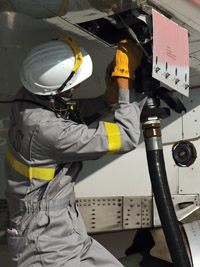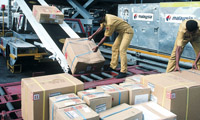Main Story
Give Asia-Pacific due recognition
Commercial success of airlines from developing regions has changed the competitive business landscape, says AAPA chief
November 1st 2012
The director general of the Association of Asia Pacific Airlines (AAPA), Andrew Herdman, is expected to renew his call for Asia-Pacific nations to gain greater influence in aviation’s global decision-making processes at this month’s AAPA Assembly of Presidents, in Kuala Lumpur. Read More »
 |
| 'When it comes to making the rules that govern this industry, the U.S. and EU still exert a very strong influence, given [their] strong political unity and long experience of legislative and regulatory oversight' |
| Andrew Herdman Director General AAPA |
He underlined the point last month in a speech to the International Aviation Club in Washington DC. “The commercial success of Asian and other airlines from developing regions of the world has fundamentally changed the competitive business landscape,” he said.
“However, when it comes to making the rules that govern this industry, the U.S. and the EU [European Union] still exert a very strong influence, given your strong political unity and long experience of legislative and regulatory oversight.
“Nevertheless, there is a growing feeling among developing countries that the influence of the U.S. and the EU is becoming somewhat disproportionate to the economic and political realities of the modern world.”
Herdman pointed out such views are not confined to the world of aviation, but also are evident in regard to the governance structures of institutions like the International Monetary Fund and World Bank.
“In a multi-polar world, governance and regulatory frameworks must adapt with the times. In terms of aviation, this suggests some rebalancing and further emphasis on the important role played by ICAO (International Civil Aviation Organization) in developing and promulgating global policy guidelines and standards.”
He told his U.S. audience that airlines based in the Asia-Pacific have established a reputation for customer service excellence and have been steadily growing their regional and global networks. “Nevertheless, it is not always widely understood just how successful these airlines have been in terms of business size and economic impact,” said Herdman.
“In 2011, airlines based in the Asia-Pacific region carried 655 million passengers and 17 million tonnes of cargo, generating aggregate revenues of $159 billion. They operated a combined fleet of almost 5,000 aircraft.
“In terms of overall market share, Asian airlines accounted for 25% of global passenger traffic (RPKs) and 40% of global air cargo traffic (FTKs). As a group, therefore, Asian carriers are commensurate with U.S. or EU carriers in passenger traffic and are clear leaders in the world of air cargo.”
He said making money in the airline industry was tough. In 2010, a relatively good year, industry reported profits of $16 billion, but on half a trillion dollars of revenues, or a profit margin of just 3%.
 |
| Jet fuel prices averaging $112 per barrel so far this year |
“Asian airlines did slightly better, earning margins of around 6% of revenue and accounted for roughly half of the industry’s global profits,” said Herdman.
“In 2011, airlines saw slower growth in passenger traffic, a weak cargo market and sharply higher oil prices, squeezing margins to the extent that overall industry profitability halved to around $8 billion. Asian airlines again accounted for about half of that total.”
He said this year had seen a continuation of that downward trend. Passenger growth continued, but air cargo markets remained depressed and oil prices stayed stubbornly high.
IATA is forecasting industry profits of $4 billion for 2012, which for an industry generating revenues of $630 billion represents a net margin of less than 1% and a profit of $1 per passenger.
At least profits appear to have stopped falling. According to IATA’s latest projections, Asia-Pacific airlines will post a $2.3 billion profit this year, some $0.3 billion better than previously forecast.
The figures were part of a recent upward revision of profitability announced by IATA director general, Tony Tyler, who said the world’s airlines would make some $4.1 billion in profits this year compared with the $3 billion forecast for the industry in June.
Herdman remained optimistic about Asia-Pacific commercial aviation despite the patchy results. “The overall trend in international air travel demand remains encouraging, as reflected in the 7.9% increase in the number of passengers carried by Asia-Pacific based airlines during the first eight months of this year,” he said.
“Whilst the overall pace of global economic activity is clearly slowing, Asian economies have so far remained relatively resilient with domestic demand still supporting business and leisure related travel.”
Herdman pointed out, however, that not withstanding the evident slowdown in the global economy, oil prices remained high, averaging US$112 per barrel so far this year, pressuring airline margins and industry profitability.
Jet fuel prices declined slightly during September on the prospect of an increased supply of crude from Saudi Arabia and North America. But after a sharp rebound from June lows, jet fuel prices were still above $130 per barrel. The past year and a half has seen the most sustained period of high jet fuel costs in recent times, with prices averaging $129 a barrel.
| 'As a group, Asian carriers are commensurate with U.S. or EU carriers in passenger traffic and are clear leaders in the world of air cargo' |
| Andrew Herdman |
Looking to the future, Herdman said air travel demand was forecast to continue growing at around 5% annually, more or less doubling in size every 15 years.
“That growth is underpinned by rising incomes, urbanisation and social development. Rapidly developing economies in Asia and other regions are lifting people out of poverty and adding significantly to the number of middle income consumers,” he said.
“The global middle class includes around two billion people, or 30% of the world’s total population, but that figure is projected to grow significantly to more than three billion in 2020 and five billion in 2030.
“China, India and other Asian markets are driving that trend, with the region’s middle class set to grow six-fold in the next two decades.
“In faster growth markets, including many developing countries in Asia, the doubling period can be even more dramatic. At 10% growth rates, as we’re seeing in China, India and several other Asian nations, you need to double fleet capacity and supporting aviation infrastructure, including airports and air navigation services, every seven years.”
Herdman said a related challenge was ensuring the industry continued to attract and train the necessary skilled manpower to support growth.
Hong Kong bucks the airfreight trend
 |
| Air cargo: overall, freight markets remain depressed |
Taken by itself, the news from the world’s biggest cargo hub at Hong Kong International Airport last month could have been seen as a major boost for airlines that have seen a key part of their revenue flow, the freight market, suffer in declining tonnages in the past year.
In September, Hong Kong Air Cargo Terminals Limited (Hactl), the major air cargo handler at Chek Lap Kok, in September saw its best year-on-year growth since January last year.
Exports were up 2%, the highest increase since the post Chinese New Year bounce of March. Imports rose 9.3%, the best growth since January. Trans-shipments were up 13.6% and the month’s total of 237,761 tonnes was the largest monthly throughput since March and marked the best year-on-year growth, (6.3%), since February.
Executive director of Hactl, Lilian Chan, said 2012 was showing better results than originally anticipated. “The slow but steady recovery in our figures also gives us reason to believe that 2013 trends should continue positively and that we will be back to sustained – if modest - overall industry growth again,” she said.
The problem is that, so far, the Hong Kong figures do not represent the wider picture. Other cargo centres are experiencing only marginal or declining growth.
Airfreight at Singapore Changi International Airport in September was 0.4% lower than a year ago and tonnages for the year to date are down 0.3%.
According to the AAPA, freight markets remain depressed as a result of weakening consumer confidence in the major developed economies of Europe and the U.S., leading to a corresponding slowdown in exports from Asia.
Asian carriers posted a 4.4% decline in international air cargo demand during the first eight months of the year.
On the passenger front, there is brighter news. The AAPA’s latest statistics, for August, reported a sustained increase in international traffic, up a healthy 6.8%, led by strong demand for regional travel.
Elsewhere, the International Air Transport Association (IATA) reported global traffic results for August showed demand for air transport is continuing to flatten, but with significant regional variations.
It also said freight volumes worldwide shrank as business and consumer confidence continued to slip.
It is against this patchy background that the heads of the region’s largest airlines will gather in Kuala Lumpur for the AAPA Assembly of Presidents this month, uncertain where their major passenger and freight markets are heading as 2013 beckons.
In Kuala Lumpur, airline chiefs will be discussing a range of issues. These will include safety, security, the environment and the heavy tax burden placed on carriers through various charges and fees that keep rising.
But seems certain they will face another tough year with volatile fuel prices, intense competition and uncertain market conditions at home and abroad.